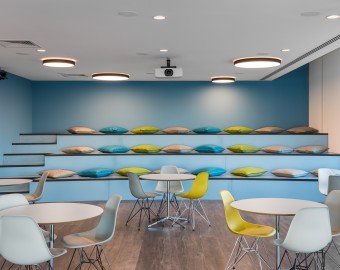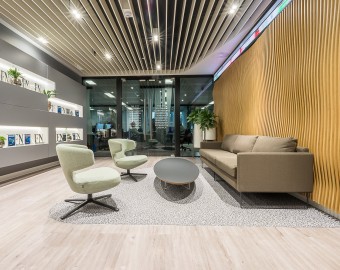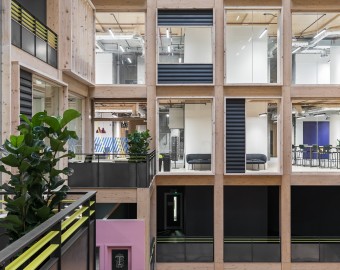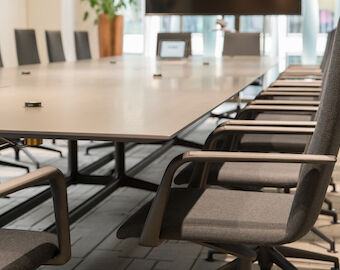Hybrid working is here to stay
The Covid-19 pandemic has led to unprecedented changes in attitude towards work, and there’s no doubt that businesses have woken up to the possibility of doing things differently. One of the biggest shifts has been towards the concept of hybrid working, whereby some or all employees have the freedom to choose where and when they work by dividing their time between working from home and coming in to a central office. As well as having implications for people and project management, the creation of a hybrid workplace also heavily impacts on how the offices are designed and configured.

In essence, hybrid working involves the flexible use of offices from which a tranche of employees may work permanently, while the remainder work from home or remotely. This contrasts with a remote model, whereby the organisation has no central office space and all employees work at home or off-site. The hybrid model of having some staff in for some of the time can be achieved with anchor desks, flexibly allocated workstations and desk booking systems, and these can by supplemented with smart meeting rooms and collaboration spaces.
The ultimate goal is to balance the needs of your employees with the benefits of working collaboratively in a shared space, which may include improved mental health and increased productivity. It’s fair to say that the return to work is a highly personal issue, with some workers feeling safer at home and others desperate to get back into the office to enjoy social contact with colleagues and working more effectively in teams. What is beyond doubt is that software and technology are available to facilitate hybrid working, and this can support businesses who recognise that, post-Covid, employees’ priorities will have changed for good. No more 9 to 5, flexible start and finish times, and more quality time with friends and family are now top of the wishlist, but without compromising productivity. One survey, for example, suggested that a staggering 90% of workers valued the flexibility to choose when and where to work above the level of salary available.
All of this has led us towards the hybrid workplace, which helps to place employee choice at the heart of successful businesses. Having the option to work from home and choose when to come into the office is the order of the day, but how does that affect the design and configuration of the space?
The affect hybrid working has on the design and configuration of office space
The physical layout of the office will change, at least for the time being, as social distancing remains a requirement. Fewer desks, more spacious social areas, viral screens and clear signposting for reception areas are a given. In fact, it’s estimated that the number of seats in the office may need to reduce by as much as 60% to achieve compliance, and that’s where hybrid working comes into its own. Simple layouts with desks, chairs and storage that are easy to clean in between shifts are likely to win out over uber-trendy setups. In addition, one-way systems or clear directional signage may be needed to ensure that the flow of people around the entire office is efficient and safe. Aside from the furniture and its positioning, hybrid working demands a fresh approach to technology, with app-based booking systems for desks, meeting rooms and even lifts coming to the fore. Kitchens and social areas will need to be configured to accommodate staff safely and will require regular cleaning after use. The IT capacity will need attention and investment, as on-site and remote workers dial in to share files and collaborate on projects. Cloud-based software and videoconferencing tools can help connect those at home with those in the office, and in doing so can help to mitigate against a loss of productivity.
Summary
For Carol Chinn, Design Partner at The Workspace Consultants, a successful hybrid working strategy needs to address not only the fundamentals of office design but also the way we think about work. ‘The effects of the pandemic will be far-reaching and long-lasting, especially when it comes to office design,’ comments Carol. ‘However, it’s important that businesses think flexibly. We all want to embrace the New Normal, but we may all need a slightly different hybrid model as we understand what works best for us. Office planning with a one desk per person ratio is probably over, and we need to think creatively about what works best for our emerging agile workforce. Post-Covid, the employers that thrive will be the ones who truly embrace the flexibility that hybrid working offers. Having probably implemented a setup up that is entirely home-based during lockdown, most businesses are now looking to enable staff to split their working between home and office, and that presents challenges in design and configuration. Here at The Workspace Consultants we’re working with a number of clients to help them transition in a way that sets them up not just for now but for the future as well. And given that everyone’s priorities are likely to be different, we find that this can often be best be achieved by involving staff in decision-making and feedback.’
Get in touch
The Workspace Consultants specialise in office design and project management in Cambridge and London, so if you’re considering adapting to hybrid working, we’d love to talk to you. Contact us today for an initial discussion on 01223 656111 or email info@theworkspaceconsultants.com.



